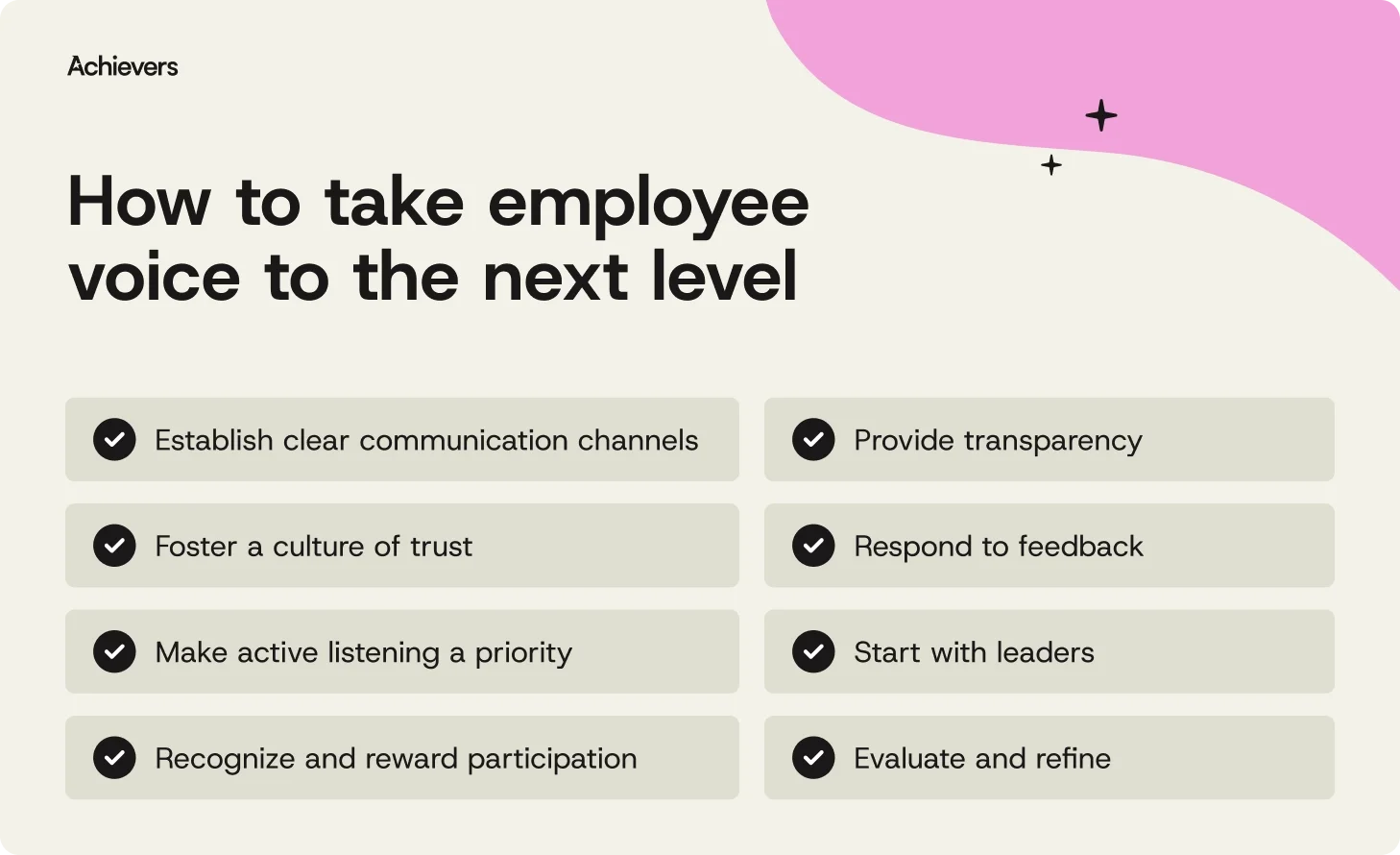Table of contents
Create a culture that means business™
Schedule a demo with an Achievers solution expert today.
Let’s cut to it: Only 1 in 4 employees feel their opinions count at work. And just 8% believe their employer actually does something with the feedback they give. If this stat had a sound, it’d be a long, disappointed sigh.
But here’s the good news — this isn’t a lost cause. It’s an open invitation.
When people feel heard (and actually see that their voice drives change), magic happens: Engagement rises. Innovation shows up. Productivity gets a healthy kick. In short, the workplace gets better for everyone.
So, are you really listening to your employees — or just nodding while thinking about your next meeting? In this blog, we’ll unpack what employee voice really means, why it matters, and how leading organizations are turning feedback into action — and action into results.
Employee voice: What it means, why it matters, and how to get it right
Employee voice — or if you want to sound extra corporate, “Voice of the Employee” (VoE) — isn’t just about giving people a chance to speak. It’s about giving them a reason to want to. At its best, employee voice is an ongoing, two-way conversation between employees and the organization, where input is invited, acted on, and never filed under “TBD.”
Done right, it empowers people to share ideas, raise concerns, and challenge the status quo — all without fear of judgment, reprisal, or eye rolls in the next team meeting. It’s not a one-time survey or a single open-door policy. It’s a shift in cultural alignment. One where listening becomes a leadership trait, and feedback becomes fuel for innovation, engagement, and trust.
When employees feel heard and know their voice drives meaningful change, they don’t just participate — they invest. That’s the real power of employee voice: It turns passive contributors into active partners in progress.
A strong employee voice culture includes:
- Open channels for input: From pulse surveys to team huddles to anonymous feedback tools — variety matters.
- Psychological safety: People need to know it’s safe to speak up (and that “radical candor” won’t cost them their bonus).
- Visible follow-through: Listening is great. Acting on feedback? Even better.
- Leadership modeling: When leaders show vulnerability and openness, employees follow suit.
- Continuous refinement: Feedback tools should evolve — just like your workforce.
Bottom line? If you want your people to help build the future of your business, you have to be willing to hear what they think of the blueprint.
How to implement employee voice (without making it weird)
Inviting employee feedback isn’t about handing out a suggestion box and hoping for the best. It’s about creating a culture where people feel safe to speak up — and confident their words won’t disappear into the void. Building that kind of workplace doesn’t happen by accident. It takes structure, trust, and yes, follow-through. Here’s how to do it right:

Establish clear communication channels
About 64% of companies have formal feedback programs (pulse surveys, suggestion boxes, etc.), yet 41% of employees have quit because they felt unheard. The fix? Offer consistent, easy-to-use avenues — weekly check-ins, quarterly surveys, digital suggestion boxes. Make these channels habitual, not heroic. That way, you’ll catch feedback early and often — and prevent the silent resignation of good ideas.
Foster a culture of trust
Leaders think 86% of employees trust them — but only 67% of employees agree. That trust gap is the silent killer of honest feedback. To bridge it, model vulnerability, listen actively, and respond — not just nod. When people believe feedback is confidential, respected, and acted upon, they speak up. And a trust-filled culture is one where great ideas — and tough truths — get a seat at the table.
Make active listening a priority
Listening is good. Active listening is better — especially when only 3 in 10 employees agree their manager listens to their ideas. It’s not just about nodding thoughtfully in meetings. It’s about asking better questions, clarifying intent, and following up with action. Whether it’s a comment in a 1:1 or an idea shared in a team chat, show that every voice is welcome — and worth your time. Because when people know they’re genuinely being heard, they’ll stop whispering their ideas to their peers and start saying them out loud to you.
Respond to feedback
Fast feedback fosters engagement: 80% of employees who received meaningful feedback in the past week say they’re fully engaged. But only 23% report getting it regularly. Fix that, and employee engagement — and productivity — soar. Even simple follow-ups count: “Thanks, we’re looking into it” is better than radio silence. When employees see their input leading to action, they give more. And that’s how feedback becomes fuel, not filler.
Provide transparency
Nothing kills employee voice faster than the black hole of unanswered feedback. In fact, 71% of employees say transparency from leadership impacts their trust — and trust is the foundation of any feedback culture. Be honest about what’s being done with the input you receive. Share updates (even if the update is “we’re still working on it”), explain decisions, and be open about what’s possible — and what’s not. A little clarity goes a long way toward making people feel heard, respected, and ready to speak up again.
Recognize and reward participation
Feedback is a gift — so treat it like one. When employees take the time to share insights or highlight challenges, don’t let it go unnoticed. A quick “thank you,” a public shoutout, or even small-scale recognition signals that their voice has value. According to Achievers Workforce Institute (AWI) data, employees who feel recognized are 4x more likely to be engaged. Recognition fuels contribution — and reinforces the behavior you want more of. So, when someone speaks up, give them a reason to do it again. (Yes, snacks count. So does gratitude.)
Start with leaders
Manager buy-in matters: teams managed by leaders trained in strengths-based feedback saw up to 22% higher engagement, 18% more productivity — and 28% lower turnover. Yet only around 44% of managers have formal training. Leadership must model transparency, ask for input, admit missteps. When leaders walk the talk, employee voice evolves from formal checkbox to everyday organizational strength.
Evaluate and refine
Organizations with robust feedback loops see a 14.9% engagement boost and up to 20% productivity gains. But success isn’t set-it-and-forget-it. Use pulse data, demographic insights, and trend analysis to spot what’s working — or not. Regularly review and tweak your approach. Demonstrating that you’re continuously listening and improving keeps voices engaged — and momentum alive.
Encourage your employees to speak up — and mean it
If you want employees to speak up, you have to show them it’s safe — and worth it. That starts with trust. Not lip service. Not a once-a-year survey. Real, ongoing, transparent communication. Supportive leadership. Recognition that makes people feel seen, not scanned.
At Achievers, we help organizations turn feedback into action — and action into impact. Our platform is built to foster trust, amplify employee voice, and recognize the people shaping your culture every day.
Because when employees feel heard, they don’t just contribute — they commit. Build that kind of culture, and your workforce won’t just speak up. They’ll help lead the way.
Employee voice FAQs
Key insights
- Discover the meaning of employee voice, how it improves performance and how to measure it.
- Find out how 86% of surveyed workers believe that emphasizing trust and transparency in the relationship between employees and the organization is very important.
- See 4 steps to take employee voice to the next level with active listening, feedback for future performance, transparency, and recognition.



